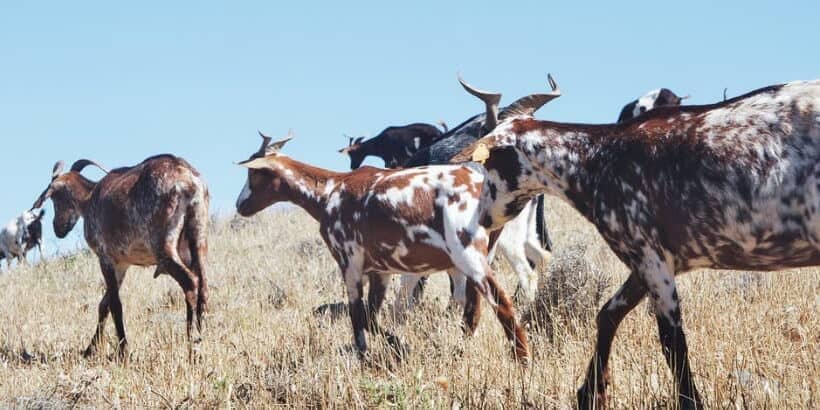Work Smarter, Not Harder: Goat Handling

If you have goats or are considering getting goats, at some point you’ll need to move them from one grazing area to another. Goat handling can be a tricky task, as they can scare easily and high levels of stress are not good for their health or productivity.
Take some advice from author and goat whisperer Gianaclis Caldwell, who has a handful of tools to use to handle your goats.
The following excerpt is from Holistic Goat Care by Gianaclis Caldwell. It has been adapted for the web.
One of the most fundamental aspects of goat farming is being able to safely and efficiently move goats from one place to another: from pasture to pasture, from pen to milking stand, and through gates and chutes. It’s also a health-related concern, at least in terms of your herd’s, and your own, mental health. If goats suffer fear and anxiety every time they are moved or handled, that can translate into stress, which in turn affects overall physical condition and productivity.
There are several ways to respect a goat’s instincts and modify your behavior when you want to approach and catch hold of them. You can also deliberately employ predator-like behavior to your advantage when you need to move goats from one place to another.
For example, a dairy might need to move one group of milk goats out of the parlor so that another can take its place. A meat or fiber goat operation might need to bring goats in off the range and sort them for processing or shearing. In these cases you can use various “pressures” to humanely move the animals without inciting them to fear.
Here are some tools that are very helpful for moving goats:
Rattle paddle: This is a long-handled plastic paddle that can be purchased from livestock supply companies. The wide paddle section is partially filled with metal pellets. The paddle serves as a physical barrier. When shaken, it makes a noise that slightly startles the animals.
Water pistol or sprayer: You can use goat’s natural dislike of water to enforce behavior, such as getting them to move through a chute or not use a one-way gate in the wrong direction. I’ve even used a motion-activated Rain Bird–type sprinkler (designed to scare off deer) to keep goats away from fruit trees.
Warning sound: I like to condition goats to respond to a harmless warning sound, such as a whistle or clicking. At first the sound is followed immediately by a physical enforcement such as a spray from a water hose. After a time, the animal responds to the sound alone.
Fencing panels: You can use rigid fencing panels to create temporary funnels, chutes, and enclosures to sort and work with goats. It’s important to set the height high enough so that fearful goats won’t try to leap over—vaulting goats can end up hurting themselves. The panels can be temporarily connected to one another with carabiners (clips) or zip ties.
Electric net fencing: You can use flexible net fencing (temporarily disconnected from the charger) as a “herding net”—either by sequentially shifting it using its built-in stakes or by having several people hold and move the fence as the herd moves.

If your farm receives frequent visits by the public, consider how spectators will interpret what they see when goats are being moved from place to place. You might understand that hitting the ground behind the goats with a stick is a harmless way to encourage them to move forward, but non-farmers might think you’re trying to hit the animal.
This is just one example of why explaining and teaching is often an important part of managing an operation with high public visibility.
Recommended Reads
Recent Articles
Aside from the sheer pleasure of telling your friends, straight-faced, that you maintain your garden using something called a “chicken tractor,” there are a slew of other benefits to working the land with a few of your animal friends. Getting rid of pests without chemicals, for one; letting them do the work of weeding and…
Read MoreIf the idea of running a vegetable farm sounds daunting, you’re not alone. What can you do to simplify techniques and reduce expenses? Where do you even begin?
Read MoreWhen you’re walking around the grocery store looking at the vegetables, it’s probably hard to imagine that a century ago there was twice the amount of options.
Read MoreIf you love tomatoes, you probably already know just how many varieties of these summertime staples there are. But do you know what makes each one unique?
Read MoreAdding the long game of trees to your system results in a deeper and more reliable, resilient and profound presence to your annual vegetable production.
Read More









